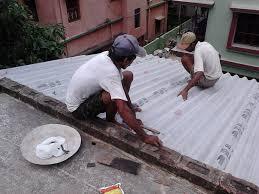Asbestos: Govt Kow-Tows to Corporate Lobbies
The government in India continues to kow-tow to corporate lobbies at the cost of the environment and public health including occupational health. While always an integral part of ruling class politics in India, as witnessed in the seemingly never-ending saga of the Bhopal Gas Disaster, this has reached new heights under the BJP government led by PM Narendra Modi which is rapidly dismantling even the already weak environmental regulatory structure. Its mantra seems to be “development” at any cost. But can any industrial or infrastructure related activity be called “development” at all if its causes serious harm to human health, if it damages the environment beyond recovery and ruins it for the next generation or maybe even for ever, with knock-on effects on the well being of human beings and the environment that sustains them?
One more instance of this trend, and the subject of this article, is the intended stance of the Government of India, in this case both the present government and its predecessor UPA government, seeking to put off international action on chrysotile Asbestos, one of the many forms in which this known carcinogenic material is prevalent, and widely used especially in India. And one again, both the governments have misused science and scientific institutions to produce “made to order” findings in order to justify the government’s political stand in support of corporate lobbies. A deeply flawed so-called study by the National Institute of Occupational Health is being used to support the industry lobby and the government’s position by whitewashing the carcinogenic character of chrysotile Asbestos.

Image Courtesy: commons.wikimedia.org
A Conference of Parties (COP 7) to the Rotterdam Convention on the Prior Informed Consent Procedure for Certain Hazardous Chemicals and Pesticides in International Trade is to be held in Paris in June 2015. The Convention is part of a “triplet” of international Treaties governing hazardous materials which includes the Basel Convention dealing with transboundary movement of hazardous materials and the Stockholm Convention dealing with regulation of Persistent Organic Pollutants. COPs for all three are being held back to back this summer in Paris. One of the issues coming up again in Paris this year, having been carried forward from earlier COPs due to the obstructionist positions taken by some countries at the behest of industry lobbies, is the proposed inclusion of chrysotile asbestos (or white asbestos as it is otherwise known) in the list of controlled materials under the Convention. It is understood that India proposes to continue its objection to the inclusion of chrysotile asbestos in the list citing this NIOH study, reversing a position it had taken at the Conference in 2011.
Asbestos highly dangerous
Asbestos being relatively inexpensive, and so often called a “poor mans material” is used in a variety of products such as cement roofing panels, insulation, automobile brake linings and so on. Asbestos consists of tiny fibres which get easily released into the surrounding air and therefore get inhaled and enter the lungs causing respiratory diseases and cancer. Asbestos poses dangers at all stages of its extraction and use, from mining where workers get exposed to raw asbestos, to manufacture of products where again workers and others in the work place or its vicinity are exposed to the fibres, and even to the general public using asbestos products such as children in schools with asbestos roofing in classrooms. That asbestos is an extremely hazardous material has long been established by relevant scientific and other bodies.
The World Health Organization (WHO) had categorically confirmed the health hazards especially carcinogenicity of all types of Asbestos going back at least two decades. Noting that studies had shown that there is no threshold or safe limit for the cancer-causing effect of asbestos, WHO concluded that “the most efficient way to eliminate asbestos-related diseases is to stop using all types of asbestos.” The International Agency for Research on Cancer set up under WHO aegis has also concluded long ago that all forms of asbestos are cancer causing and should therefore be completely eliminated. The International Labour Organization (ILO), especially in a special resolution of 2006, has also pronounced on the hazards posed to workers exposed to asbestos in mining, using asbestos for making products and in handling of products made with asbestos, including even family members of asbestos workers who get exposed to asbestos fibres on the clothes of workers.
Other organizations to recognize the dangers posed by asbestos and calling for its eventual total elimination include the World Federation of Public Health Associations, the International Commission on Occupational Health, the Union for International Cancer Control representing 770 member organisations in 155 countries including the Indian Cancer Society, the International Trade Union Confederation and the Indian Association of Occupational Health.
India & Asbestos
In India too, numerous scientific studies and governmental committees have earlier concluded as to the hazards posed by asbestos. The Factories Act 1948 itself recognizes asbestos as a hazardous material. India’s Inventory of Hazardous Chemicals Import in India includes asbestos among 180 hazardous chemicals imported into India, the inventory having been prepared by the Central Pollution Control Board (CPCB) constituted under the Ministry of Environment & Forests.
Back in 1995 the Supreme Court had ruled, in a case filed by a consumer rights organization, that asbestos was clearly a hazardous substance whose adverse impact on human health went far beyond the immediate work place in mines or product making factories and extended well into homes and pubic places wherever the general public could come into contact with the material. The apex Court had then ruled that the Government of India should implement measures to strictly control and regulate use of asbestos, especially by following the guidelines and recommendations issued from time to time by the ILO, with a review after every 10 years.
In 2006 in connection with another case, the Supreme Court noted that more than 15 years had elapsed since its previous order and that the problems posed by asbestos had become more acute and demanded more stringent action. Internationally it had by now come to be recognized that it was virtually impossible to implement measures for “controlled use” of asbestos since even secondary exposure with no threshold limit had been seen to cause all kinds of health problems including cancer. The Court noted that ILO had passed a very specific resolution in 2006 calling for a complete ban on all mining, manufacture, recycling and use of all forms of asbestos.
Following this judgement, the Government had adopted several measures including setting up of an Advisory Committee in early 2012 to go into how the ILO Resolution could be implemented. This Committee had not submitted its Report by the time the UPA government was voted out of power and the new BJP Government has not followed up on it either. The National Human Rights Commission (NHRC) is also pursuing a case seeking compliance with the Supreme Court's order
Sustained Campaign
Not that no action had been taken in the interim. Due to the sustained campaign against asbestos and various governmental actions, there had been a substantial reduction in use of asbestos and a cessation of asbestos mining in India. Consumption of asbestos in India has dropped by 39% from 2012 to 2013, that is from 493,086 to 302,668 tons, which is still intolerably large. Regrettably, India remains among the world's highest users of asbestos which is imported from a number of countries that continue to mine and export asbestos such as Canada, Brazil, Russia and China.
Currently a Bill, originally introduced in 2009 under UPA, has been reintroduced in Parliament in November 2014, namely the White Asbestos (Ban on Use and Import) Bill, 2014, seeking use of safer and cheaper alternatives to white or chrysotile asbestos. The Bill calls for "a total ban on use and import of white asbestos in the country and to promote the use of safer and cheaper alternative to white asbestos and for matters connected therewith and incidental thereto.”
In parallel, however, asbestos manufacturers associations and industry lobbies continued putting pressure on government in one way or another not to impose any restrictions or regulations governing the use of asbestos. Whenever an international convention came around requiring Government of India to take a stand, or whenever some executive or legislation action was forthcoming, these industrial lobbies would put out huge advertisements in newspapers and other mass media claiming that asbestos was not harmful, making false distinctions between chrysotile asbestos and other forms of asbestos etc.
All central Trade Unions have also adopted a Resolution demanding a complete ban on all forms of asbestos and introduction of alternative materials, which are well known and widely available, so as not to result in loss of employment to workers in the sector.
India, NIOH Study and Rotterdam Convention
It should be noted that, whereas the growing consensus and momentum in international bodies including ILO, WHO etc as well as among workers’ organizations, think tanks, popular movements and citizens groups were increasingly converging on a total ban on asbestos, the Rotterdam Convention was yet only confined to controlling imports and exports, and required exporters to inform the importing country that hazardous materials listed under the Convention were being exported to that country. Even on this, many countries with vested interests either as exporters or as importers continued to stall the agreement by refusing to endorse it or refusing to add one or other substance to the List. Canada, for instance, despite severely restricting the use of asbestos within that country, exported as much as 95 percent of asbestos mined in Canada, of which almost half was exported to India.
In 2004, India informed the Convention that it would take a stand on asbestos after a study which it had asked the NIOH to conduct. This Report underwent several “reviews” and modifications, and over the years was comprehensively criticized and rejected by think tanks, peoples movements, scientists and others in India and abroad. However, citing this Report, India continued to block inclusion of asbestos in the Convention list as recommended by its Chemicals review Committee in 2004 and 2006.
To everyone’s surprise, however, India reversed its position in 2010 and, to a standing ovation in the 5th Conference of Parties (COP5), agreed to the inclusion of asbestos in the List. But this joy at India going along with world scientific opinion was short lived. Citing the ‘Final Report’ of the NIOH study, in 2013 India once again reversed its position and went back to its earlier stance of not accepting inclusion of asbestos in Annex III of the Rotterdam Convention.
The NIOH study, in direct contradiction to the position of other Indian authorities or relevant bodies, and also contradicting earlier studies by the same Institute as well as the publicly communicated opinion and published papers of its former Directors, essentially stated that asbestos especially chrysotile asbestos was not a hazardous substance and did not pose a threat to the safety of workers or the general pubic. This NIOH study has used deeply flawed methodology and arrived at completely non-justifiable conclusions. The study has collected data from workers classified on the basis of age rather than duration of exposure as should have been done, and has somehow managed to select workers mostly under 35 years of age and who had around 5 years or less of exposure to asbestos. It is well known that asbestosis and related cancers are slow gestation diseases, taking around 20 years to develop and manifest themselves. This is like picking teenagers who have been smoking a little for a year or two and concluding that there is no risk of cancer! There are numerous other and quite fundamental flaws in the NIOH study which make it clear that the very objective of the study was to somehow justify a pre-determined conclusion tailor-made to suit the interests of industry lobbies.
NIOH has done itself no credit whatsoever by conducting and releasing such a study. This has caused great harm to the reputation of not just this institution but of science in India as a whole. As argued in these columns earlier too, if scientific institutions and scientists in India allow themselves to be used in this manner to produce tailor-made studies to suit the powers that be, they will also lose credibility in the eyes of the general public within this country.
This spurious NIOH study needs to be withdrawn by NIOH.
And Government of India needs to agree to inclusion of asbestos in the list for Prior Informed Consent at the forthcoming June 2015 COP of the Rotterdam Convention in Paris.
Disclaimer: The views expressed here are the author's personal views, and do not necessarily represent the views of Newsclick
Get the latest reports & analysis with people's perspective on Protests, movements & deep analytical videos, discussions of the current affairs in your Telegram app. Subscribe to NewsClick's Telegram channel & get Real-Time updates on stories, as they get published on our website.
























